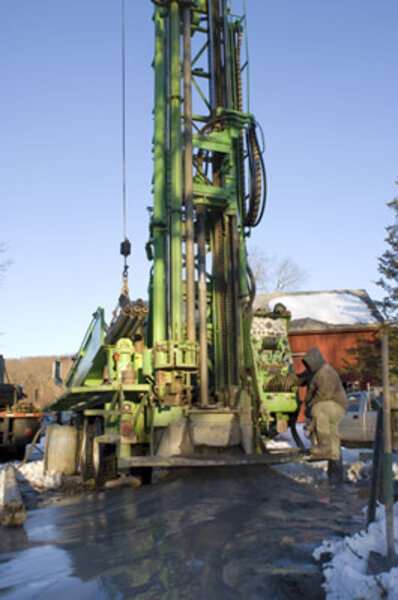Solar power vs. geothermal: Which works better?
Loading...
As I learn about green options as we renovate Sheep Dog Hollow, I have definitely tripped and stumbled along the way.
In my most recent post, I noted what could have been my biggest wrong-footed move to date: choosing an expensive geothermal heating system when I could have leased a solar system for the cost of my monthly electric bill – at least, that’s how it seems on the surface.
But like all things green and cutting edge, the situation is more complex than it first appears.
Let me set the stage, though. The man from our local solar leasing company came to give a quote for our current home and was clearly taken aback when I mentioned that we had chosen geothermal for the house we’re renovating.
“Wow, that could cost you,” he said. “Your monthly electric bills could be pretty high.”
Since the geothermal system had already cost about $20,000 more than a traditional heating system, I was not pleased to hear his analysis of why it would also cost more to operate monthly than solar.
His reasoning went this way: Geothermal systems use a compressor and a heat pump to circulate the piped warm water from beneath the ground into the house and raise its temperature to a toasty 72 degrees F. That’s similar to what’s used in a central air conditioning system (but backwards and in winter.)
Since we don’t have central air conditioning, I was stunned to hear that during the summer, people who do have it can see their electric bills spike to $400 or $500 month.
“Same thing is happening with geothermal," he said. "You’re running a pump and a compressor all of the time, and you get consistently high electric bills, but for 12 months, not just during summer. So you have to be prepared for that. Some people in this area with geothermal have had $500-a-month electric bills.”
That might be true, but they’re also not paying $600 dollars a month in winter to keep their heating oil tanks full.
Nonetheless, his sales pitch got me. With the solar lease program, we could have put in a solar system for zero down. I couldn’t help but slap the palm of my hand to my head and think, “What have I done?”
(That’s especially true because my fiancé, Martin, was adamantly opposed to geothermal and I had prevailed upon him. If this was true about solar, I’d never hear the end of it.)
After the solar man left, I called Ray Sima, who had put in our geothermal wells. He and his family have been using geothermal heat here in chilly New England for the past 20 years.
“For every quarter you pay in electricity, you get 75 cents free in heat,” he said reassuringly “We’re essentially heating our house with a hair dryer. Our highest electric bill this winter has been $284. In the summer, it’s significantly lower.”
I don’t know the size of his house, but it still set my mind to rest. And then Ray had his say about solar:
“We’ve been playing the solar game since the 1970s. Here in New England, it just doesn’t work well because days like today, it’s too cloudy.”
Hmmm. But solar has improved significantly since the 1970s, so much so that it can easily provide enough electricity in cloudy New England to at least keep the lights on and the water hot.
That’s what prompted the state to set up the Connecticut Solar Lease Program to make it possible for middle-class people to go at least partially solar. And it is reasonably priced.
In our current 2,000-square-foot home, according to the analysis by BeFree Solar, it would cost only $99 a month to lease enough panels to provide our current electric needs (which don’t include heat or hot water). The panels would cover the entire front roof of the barn – which faces south.
I’d probably need double or triple the number of panels if I wanted to heat with solar, too, and I’m not sure where I’d put them (our house is in a very shady part of the property.) I can’t see solar heat as a viable option here unless I want to give up my garden.
At Sheep Dog, which is twice the size of our current home, to use solar panels to effectively heat the whole house, we’d probably have to cover an acre or two to get enough electricity. (All right, that’s probably an exaggeration, but not too much of one.)
So here’s what I’ve finally concluded: Geothermal was the right call in terms of finding an alternative to oil or gas boilers to heat the house, since we're in New England. But it also would make sense to add solar panels to augment additional electric needs.
But I’m going to have to wait on that. Right now, it’s impossible now to know how much electricity our lights and geothermal system will use at Sheep Dog. We can’t even estimate basic electric needs – for lights, computers, etc. – because the house had been abandoned for the past 20 years.
So, we’re going full steam ahead with our current plan and then, when we know what our electric load will be, we’re planning to lease some of those very reasonably priced solar panels.
Editor’s note: Alexandra Marks blogs twice a week about her green and budget-friendly restoration of a 1902 farmhouse in Connecticut. Click here to find all her blog posts and articles.





